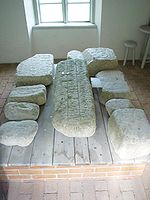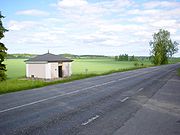
Stones of Mora
Encyclopedia

Mora Meadow
In Lagga parish about 10 km south-east of UppsalaUppsala
- Economy :Today Uppsala is well established in medical research and recognized for its leading position in biotechnology.*Abbott Medical Optics *GE Healthcare*Pfizer *Phadia, an offshoot of Pharmacia*Fresenius*Q-Med...
, but (since 2003) in neighbouring Knivsta Municipality
Knivsta Municipality
Knivsta Municipality is a municipality in Uppsala County in east central Sweden. Its seat is located in the town of Knivsta, with some 7,100 inhabitants.-History:...
, is Mora äng (Mora Meadow). The location is at equal distance from the Things
Thing (assembly)
A thing was the governing assembly in Germanic and introduced into some Celtic societies, made up of the free people of the community and presided by lawspeakers, meeting in a place called a thingstead...
of the old folkland
Folkland
The Folklands are the name for the original Swedish provinces of Tiundaland, Attundaland, Fjärdhundraland, and Roden which in the 1296 united to form the province of Uppland. They were originally united by electing a common king who administered the sacrifices at Uppsala and who was the commander...
s Attundaland
Attundaland
Attundaland was the name given to the southeastern part of the present day province of Uppland, north of Stockholm. Its name refers to its role of providing 800 men and 32 ships for the leidang of the Swedish kings at Uppsala.Snorri Sturluson relates that Tiundaland was the richest and most...
and Tiundaland
Tiundaland
Tiundaland is a historic region, Folkland, and since 1296 part of the modern province of Uppland. It originally meant the land of the ten hundreds and referred to its duty of providing 1000 men and 40 ships for the Swedish king's leidang....
.
The Thing of Mora
This was the location of Mora ThingThing (assembly)
A thing was the governing assembly in Germanic and introduced into some Celtic societies, made up of the free people of the community and presided by lawspeakers, meeting in a place called a thingstead...
(called Múlaþing by Snorri Sturluson
Snorri Sturluson
Snorri Sturluson was an Icelandic historian, poet, and politician. He was twice elected lawspeaker at the Icelandic parliament, the Althing...
, see Þorgnýr the Lawspeaker
Þorgnýr the Lawspeaker
Þorgnýr the Lawspeaker is the name of one of at least three generations of lawspeakers by the name Þorgnýr, who appear in the Heimskringla by the Icelandic scholar and chieftain Snorri Sturluson, and in the less known Styrbjarnar þáttr Svíakappa and Hróa þáttr heimska...
), where the Swedish kings were elected. After his election was decided, the king was elevated on top of a flat stone and hailed by his subjects.
The law of Uppland
Uppland
Uppland is a historical province or landskap on the eastern coast of Sweden, just north of Stockholm, the capital. It borders Södermanland, Västmanland and Gästrikland. It is also bounded by lake Mälaren and the Baltic sea...
and Södermanland
Södermanland
', sometimes referred to under its Latin form Sudermannia or Sudermania, is a historical province or landskap on the south eastern coast of Sweden. It borders Östergötland, Närke, Västmanland and Uppland. It is also bounded by lake Mälaren and the Baltic sea.In Swedish, the province name is...
states: The three folklands, i.e. Tiundaland
Tiundaland
Tiundaland is a historic region, Folkland, and since 1296 part of the modern province of Uppland. It originally meant the land of the ten hundreds and referred to its duty of providing 1000 men and 40 ships for the Swedish king's leidang....
, Attundaland
Attundaland
Attundaland was the name given to the southeastern part of the present day province of Uppland, north of Stockholm. Its name refers to its role of providing 800 men and 32 ships for the leidang of the Swedish kings at Uppsala.Snorri Sturluson relates that Tiundaland was the richest and most...
and Fjärdhundraland
Fjärdhundraland
Fjärdhundraland or the land of the four hundreds is, since 1296, a part of the province of Uppland in Sweden. Its name refers to its role of providing 400 men and 16 ships for the leidang of the Swedish king at Uppsala....
, shall first elect king. Then the election will be sanctioned by the lawspeaker
Lawspeaker
A lawspeaker is a unique Scandinavian legal office. It has its basis in a common Germanic oral tradition, where wise men were asked to recite the law, but it was only in Scandinavia that the function evolved into an office...
of Uppland and then by all his subordinate lawspeakers in the rest of the kingdom, one by one. This process was done during the so called Eriksgata
Eriksgata
Eriksgata is the name of the traditional journey of the newly elected medieval Swedish kings through the important provinces to have their election confirmed by the local assemblies...
.
The Westrogothic law reminded the Geats that they had to accept this election: Sveær egho konung at taka ok sva vrækæ meaning Swedes have the right of choosing and deposing the king.
The detail that the Swedes were not only entitled to elect their king, but that they also had the right to depose him was institutionalized a long time before, as attested by Snorri Sturlason's (died 1241) accounts of Swedish history (the speech of Þorgnýr the Lawspeaker, and the deaths of Domalde
Domalde
In Norse mythology, Domalde, Dómaldi or Dómaldr was a Swedish king of the House of Ynglings, cursed by his stepmother, according to Snorri Sturluson, with ósgæssa, "ill-luck". He was the son of Visbur....
and Egil
Egil
-People:*Agilaz, a legendary archer of Germanic mythology and a brother of Völund.*Egil, a character in the poem Hymiskvida.*Egill Örn Egilsson, also known as Eagle Egilsson, Icelandic director and cinematographer....
in the Heimskringla
Heimskringla
Heimskringla is the best known of the Old Norse kings' sagas. It was written in Old Norse in Iceland by the poet and historian Snorri Sturluson ca. 1230...
). The location was on the border of a wetland, and according to Snorri, five kings had been drowned in this wetland, when the people had been displeased.
The newly elected king also had to go around Sweden on the Eriksgata
Eriksgata
Eriksgata is the name of the traditional journey of the newly elected medieval Swedish kings through the important provinces to have their election confirmed by the local assemblies...
, including the Geatish provinces. It was thus a sort of federation where the king started with his election at Mora Thing and then travelled to throughout the kingdom to have the election confirmed by the local assemblies.
Stone of Mora

Denmark
Denmark is a Scandinavian country in Northern Europe. The countries of Denmark and Greenland, as well as the Faroe Islands, constitute the Kingdom of Denmark . It is the southernmost of the Nordic countries, southwest of Sweden and south of Norway, and bordered to the south by Germany. Denmark...
. Gustav Vasa and John III
John III of Sweden
-Family:John married his first wife, Catherine Jagellonica of Poland , house of Jagiello, in Vilnius on 4 October 1562. In Sweden, she is known as Katarina Jagellonica. She was the sister of king Sigismund II Augustus of Poland...
are said to have tried to reconstruct the Stones of Mora without success.
One of the fragments is known as the stone Three Crowns since it is the earliest known example of the use of Sweden's national symbol. The fragment is what remains of the election of Albert of Mecklenburg.
Elections of which documents have survived
- Magnus LadulåsMagnus III of SwedenMagnus III Ladulås of Sweden, Swedish: Magnus Birgersson or Magnus Ladulås was King of Sweden from 1275 until his death in 1290....
. There is a document which tells that he was elected at the Stones of Mora in 1275. - Magnus IV was elected at the stones on July 8, 1319.
- Kristian IChristian I of DenmarkChristian I was a Danish monarch, king of Denmark , Norway and Sweden , under the Kalmar Union. In Sweden his short tenure as monarch was preceded by regents, Jöns Bengtsson Oxenstierna and Erik Axelsson Tott and succeeded by regent Kettil Karlsson Vasa...
, in 1457, he was the last to be elected at the stones.
The building
The building where the fragments are contained was constructed by Carl Wijnbladh in 1770.Knivsta coat of arms
In 2002, in anticipation of KnivstaKnivsta Municipality
Knivsta Municipality is a municipality in Uppsala County in east central Sweden. Its seat is located in the town of Knivsta, with some 7,100 inhabitants.-History:...
, part of the municipality of Uppsala
Uppsala
- Economy :Today Uppsala is well established in medical research and recognized for its leading position in biotechnology.*Abbott Medical Optics *GE Healthcare*Pfizer *Phadia, an offshoot of Pharmacia*Fresenius*Q-Med...
since 1971, regaining its status of a municipality of its own in 2003, the Swedish state herald designed and registered a coat of arms for Knivsta based on the stone of Mora motif: an open crown over a heraldic trimount. The design was based on a sketch by a schoolchild, one of many emerging from a local contest.
See also
- Stone of SconeStone of SconeThe Stone of Scone , also known as the Stone of Destiny and often referred to in England as The Coronation Stone, is an oblong block of red sandstone, used for centuries in the coronation of the monarchs of Scotland and later the monarchs of England, Great Britain and the United Kingdom...
- Germanic king
- Lia FáilLia FáilThe Lia Fáil , also known as the Coronation Stone of Tara, is a stone at the Inauguration Mound on the Hill of Tara in County Meath in Ireland, which served as the coronation stone for the High Kings of Ireland. In legend, all of the kings of Ireland were crowned on the stone up to Muirchertach...
- Prince's StonePrince's StoneThe Prince's Stone is the reversed base of an ancient Ionic column that played an important role in the ceremony surrounding the installation of the princes of Carantania in the Early Middle Ages...

